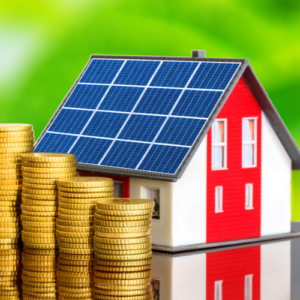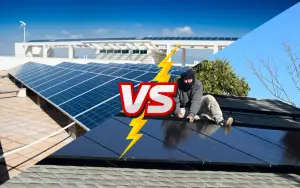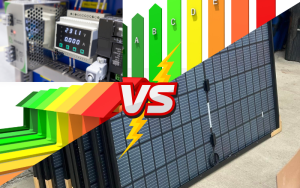INTRO
Are you tired of skyrocketing electricity bills? You’re not alone. More homeowners and businesses are switching to renewable energy systems, especially solar power, to take control of their energy costs. But how much can you really save with a renewable energy system? The answer depends on several factors, including your location, energy usage, and available incentives. In this guide, we’ll break down the costs, potential savings, and benefits of investing in solar energy.
How Does a Renewable Energy System Save Me Money?
 A renewable energy system, such as solar panels, generates electricity using sunlight, which is free. By producing your own power, you reduce your dependence on the utility grid. Here’s how you save money:
A renewable energy system, such as solar panels, generates electricity using sunlight, which is free. By producing your own power, you reduce your dependence on the utility grid. Here’s how you save money:
- Lower electricity bills – The more energy your system produces, the less you need to buy from the grid.
- Protection from rising energy costs – Utility rates increase over time, but solar helps lock in lower energy expenses.
- Sell excess energy – If your system produces more power than you use, you may receive credits on your electricity bill through net metering.
What Factors Affect My Solar Savings?
The amount you save depends on:
- System size and efficiency – A larger system generates more electricity, leading to greater savings.
- Electricity rates in your area – Higher utility costs mean greater potential savings.
- Sunlight exposure – Areas with more sunlight generate more solar power, increasing savings.
Understanding the Solar Payback Period
The solar payback period refers to how long it takes for your energy savings to cover the cost of your system. On average, this period ranges from 6 to 10 years. Here’s how it works:
- Initial investment – The cost of purchasing and installing a solar energy system.
- Energy savings – Monthly reductions in your electricity bill.
- Incentives and rebates – Tax credits and net metering can accelerate payback.
For example, if your system costs $15,000 and saves you $1,500 per year, your payback period would be 10 years.
How Much Can I Reduce My Electricity Bill?
Solar energy can significantly reduce your monthly bill, depending on your setup:
- Solar-only system – Cuts electricity costs by 50-80%.
- Solar + battery storage – Can eliminate bills entirely by providing power even at night.
Some homeowners even receive negative electricity bills, meaning their utility provider pays them for excess energy sent back to the grid. Contact Us: Solar Panels NovaMax
 Tax Credits and Incentives That Increase Savings
Tax Credits and Incentives That Increase Savings
The Federal Investment Tax Credit (ITC) currently allows you to deduct 30% of your system’s cost from your federal taxes. Additional state and local incentives may include:
- Rebates – Reduce upfront installation costs.
- Net metering – Earn credits for excess energy returned to the grid.
- Property tax exemptions – Solar systems may increase home value without raising taxes.
Solar Financing Options: Cash vs. Loans vs. Leases
You don’t need to pay for solar upfront. Here’s a breakdown of financing options:
- Cash purchase – Highest savings, shortest payback period.
- Solar loan – Spread costs over time while still benefiting from incentives.
- Solar lease/Power Purchase Agreement (PPA) – No upfront cost, but lower savings over time.
Net Metering: How to Sell Excess Energy Back to the Grid
Net metering allows you to sell unused electricity back to your utility provider in exchange for bill credits. This can dramatically increase your savings by offsetting nighttime energy use. The best net metering programs are available in states like California, New York, and Texas.
Off-Grid vs. Grid-Tied Solar: Which Saves More?
A grid-tied system connects to your local utility, offering stability and net metering benefits. An off-grid system requires batteries but offers complete energy independence. While off-grid systems require a larger initial investment, they can be beneficial for remote locations with unreliable power access. Contact Us: Solar Panels NovaMax
Maintenance Costs: Are There Hidden Expenses?
Solar panels are low-maintenance, but occasional costs may include:
- Cleaning panels – Dirt and debris can reduce efficiency.
- Inverter replacement – Typically needed every 10-15 years.
- Battery maintenance – If you have energy storage, batteries may require servicing.
DIY vs. Professional Solar Installation: What’s Best for Savings?
While DIY solar kits may seem cheaper upfront, professional installation ensures:
- Proper permitting and grid connection
- Maximum system efficiency
- Long-term warranty protection
Most homeowners find that professional installation results in higher energy production and greater long-term savings.
Testimonials
” With Solar Panels NovaMax My electricity bill dropped by 75% after switching to solar. Best investment ever!” — Jason L., Austin, TX
“I love getting credits on my bill thanks to net metering. Solar pays for itself!” — Melissa D., San Diego, CA
“The tax credits alone made my system so affordable. I’m saving thousands!” — Robert H., Miami, FL
The average cost ranges from $15,000 to $25,000 before incentives, depending on system size and location.
Yes! While solar panels generate less electricity on cloudy days, they still produce power. Battery storage can help provide energy during low-sunlight periods.
With net metering, excess energy is sent to the grid in exchange for bill credits. Some states even offer cash payments for surplus power.
Most solar panels last 25-30 years with minimal efficiency loss over time.
While DIY installation is possible, hiring a professional ensures proper setup, efficiency, and warranty coverage.
 Did You Know?
Did You Know?
Did you know that solar panels can increase your home’s value by up to 4%? Homebuyers are willing to pay more for homes with lower energy costs!
By investing in a renewable energy system, you can significantly reduce energy costs, take advantage of tax incentives, and gain energy independence. Ready to start saving? Explore your solar options today!
TL;DR Summary
- A renewable energy system can cut electricity costs by 50-100%.
- The average solar payback period is 6-10 years.
- Tax credits and rebates significantly lower installation costs.
- Net metering lets you earn credits for excess energy.
- Professional installation ensures maximum savings and efficiency.



